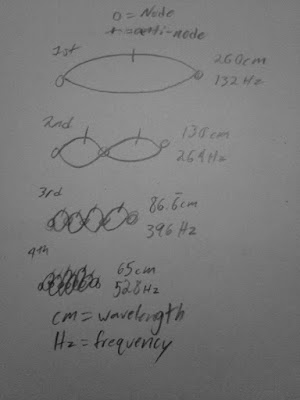My Diddley Bow creates sounds by the use of vibrations. The single string is vibrated via plucking, and that vibration is what we call sound. Sound waves range from a variety of sounds and pitches which visually can be represented with different lengths/height (amplitude) based on the middle point, and the distance of 2 peaks (a full complete cycle, showing us the wavelength, which is always less than the frequency as high pitches=small distance between peaks, and that's known as the wavelength). Now incidentally, there's another mechanic of sound yet it's not demonstrated by my instrument, which is known as the Doppler Effect. It occurs when sound waves seem to contract or spread apart based on motion of the listener or source. If you've ever heard a train, motorcycle, or ambulance pass by, making a lot of noise, you'll notice that the pitch is higher when it moves towards you (but not yet present) and has a lower pitch when moving away from you, going off into the distance. This overlapping of sound waves is how the sound gets amplified inside of the can as the string vibrates. So rather than a pitch change it's more of an amplification, thus not replicating the Doppler effect.

Now with a string that goes on for a foot (12 inches) before vibrations cease, and a thickens of 0.027 inches, I have a Diddley Bow that (based on a tuner) creates a Frequency of 132hz (hertz), translating to an approximate wavelength of 260cm. The harmonics are simple to calculate, as I just need to find the factors in this case as the harmonics go by quarters (including half) and thirds.
The picture below visually demonstrates how to find each harmonic, which is simple. Divide the wavelength by the harmonic number, and multiple the original frequency by that same number. Since we're talking about math here, I'll tell you the volume of my can, which I found by multiplying the height (4 in) by its squared radius (2^2) which is also multiplied by π (pi, 3.14, etc.). It turns out that there's about 50 cubed inches of space inside of the can, which is interesting to think about considering how more than 4 feet of a substance can fit inside something 12 times shorter than that in height.
 Now if you're interested in what each part is supposed to signify, then the picture below shows the essential parts that are supposed to be represented.
Now if you're interested in what each part is supposed to signify, then the picture below shows the essential parts that are supposed to be represented.And if you actually want to hear how the guitar works, than you can check out the embedded SoundCloud just below. Plus, a special thanks to a fellow blogger, who you can check out here, for the building process. With that, I'd say that if there's anything that I'd do over, it's be sure to be prepared. I was very late on finding a tin can which pretty much set back 60% of the research and data available, but I hope you enjoyed, and thanks for reading!


No comments:
Post a Comment